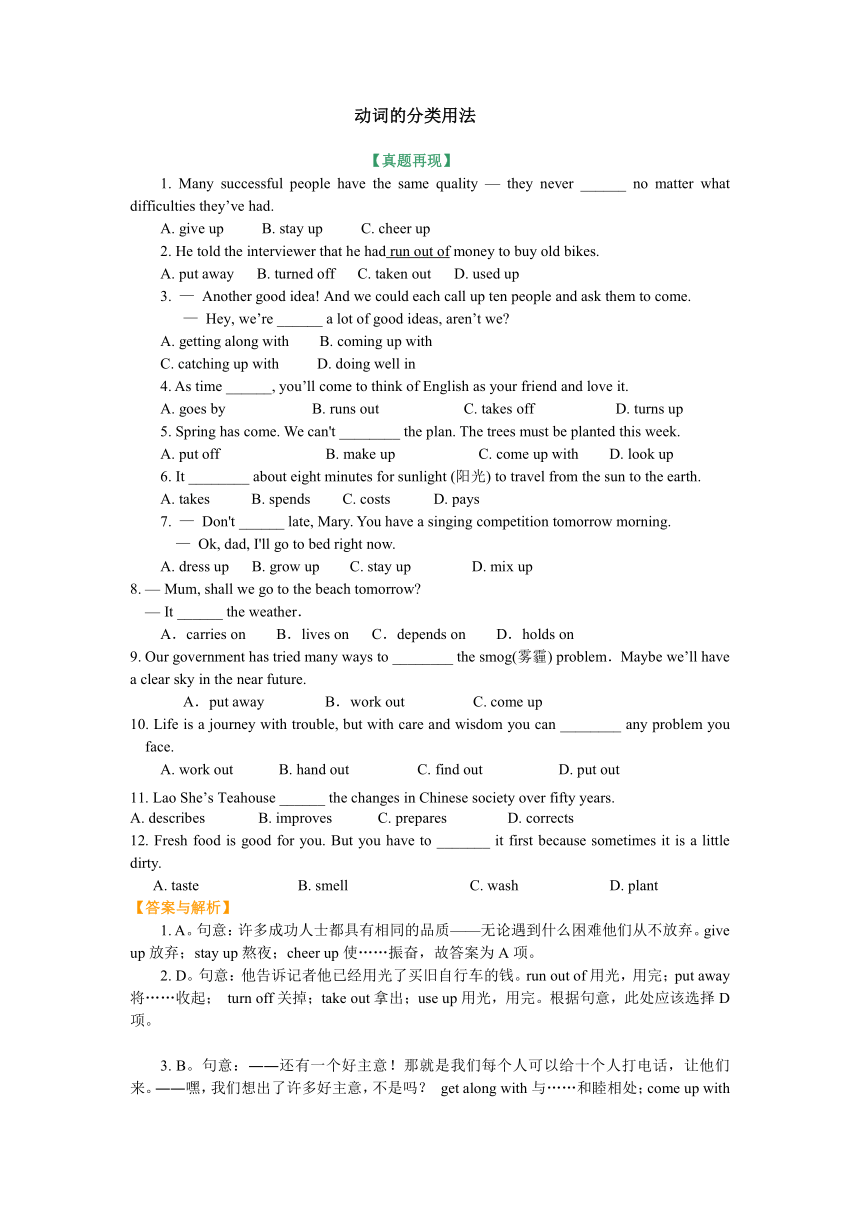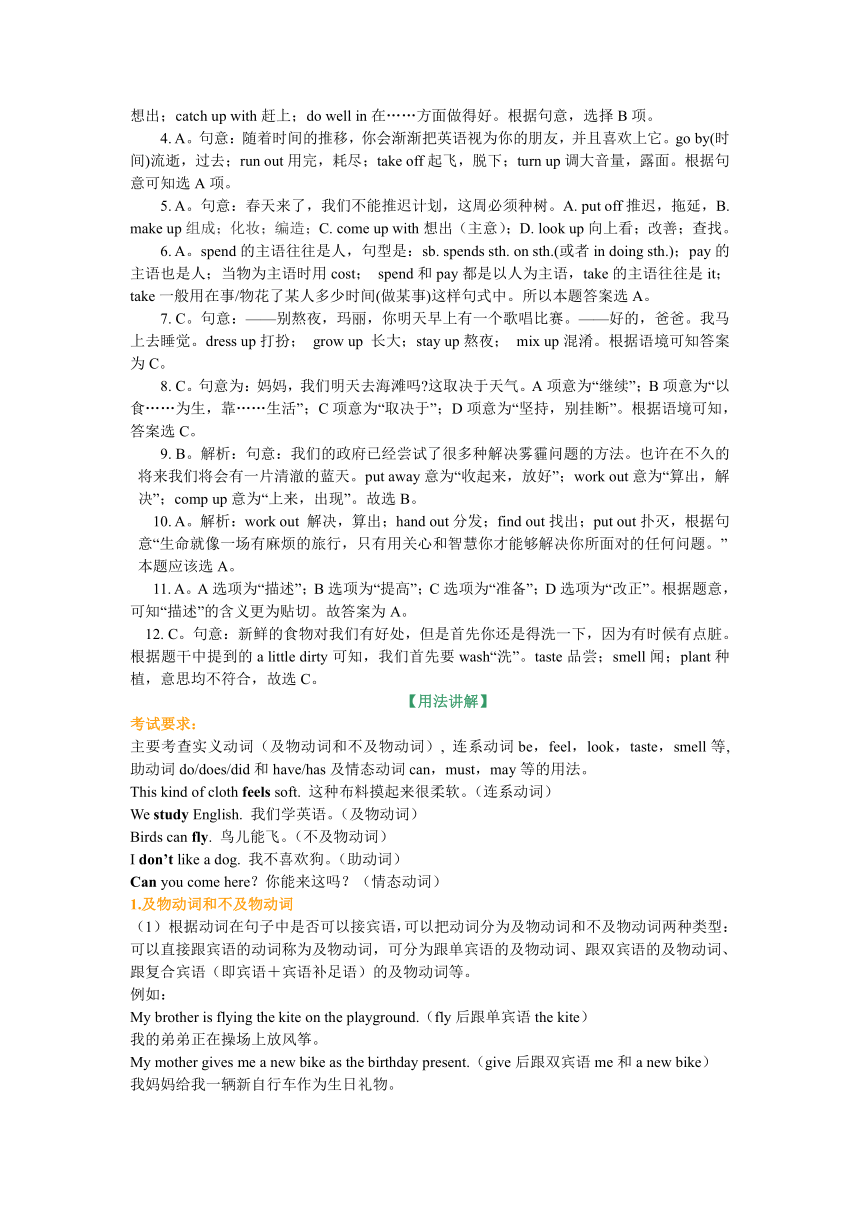动词的分类用法(基础知识含答案)
图片预览


文档简介
动词的分类用法
【真题再现】
1. Many successful people have the same quality — they never ______ no matter what difficulties they’ve had.
A. give up B. stay up C. cheer up
2. He told the interviewer that he had run out of money to buy old bikes.
A. put away B. turned off C. taken out D. used up
3. — Another good idea! And we could each call up ten people and ask them to come.
— Hey, we’re ______ a lot of good ideas, aren’t we
A. getting along with B. coming up with
C. catching up with D. doing well in
4. As time ______, you’ll come to think of English as your friend and love it.
A. goes by B. runs out C. takes off D. turns up
5. Spring has come. We can't ________ the plan. The trees must be planted this week.
A. put off B. make up C. come up with D. look up
6. It ________ about eight minutes for sunlight (阳光) to travel from the sun to the earth.
A. takes B. spends C. costs D. pays
7. — Don't ______ late, Mary. You have a singing competition tomorrow morning.
— Ok, dad, I'll go to bed right now.
A. dress up B. grow up C. stay up D. mix up
8. — Mum, shall we go to the beach tomorrow
— It ______ the weather.
A.carries on B.lives on C.depends on D.holds on
9. Our government has tried many ways to ________ the smog(雾霾) problem.Maybe we’ll have a clear sky in the near future.
A.put away B.work out C. come up
10. Life is a journey with trouble, but with care and wisdom you can ________ any problem you face.
A. work out B. hand out C. find out D. put out
11. Lao She’s Teahou ( http: / / www.21cnjy.com )se ______ the changes in Chinese society over fifty years.
A. describ ( http: / / www.21cnjy.com )es B. improves C. prepares D. corrects
12. Fresh food is good for you. But you have to _______ it first because sometimes it is a little dirty.
A. taste B. smell C. wash D. plant
【答案与解析】
1. A。句意:许多成功人士都具有相同的品质——无论遇到什么困难他们从不放弃。give up放弃;stay up熬夜;cheer up使……振奋,故答案为A项。
2. D。句意:他告诉记者他已经用光了买旧自行车的钱。run out of用光,用完;put away将……收起; turn off关掉;take out拿出;use up用光,用完。根据句意,此处应该选择D项。
3. B。句意:――还有一个好主意!那就是我们每个人可以给十个人打电话,让他们来。――嘿,我们想出了许多好主意,不是吗? get along with与……和睦相处;come up with想出;catch up with赶上;do well in在……方面做得好。根据句意,选择B项。
4. A。句意:随着时间的推移,你会渐渐把英语视为你的朋友,并且喜欢上它。go by(时间)流逝,过去;run out用完,耗尽;take off起飞,脱下;turn up调大音量,露面。根据句意可知选A项。
5. A。句意:春天来了,我们不能推迟计划,这周必须种树。A. put off推迟,拖延,B. make up组成;化妆;编造;C. come up with想出(主意);D. look up向上看;改善;查找。
6. A。spend的主语往往是人,句型是:sb. spends sth. on sth.(或者in doing sth.);pay的主语也是人;当物为主语时用cost; spend和pay都是以人为主语,take的主语往往是it;take一般用在事/物花了某人多少时间(做某事)这样句式中。所以本题答案选A。
7. C。句意:——别熬夜,玛丽,你明天早上有一个歌唱比赛。——好的,爸爸。我马上去睡觉。dress up打扮; grow up 长大;stay up熬夜; mix up混淆。根据语境可知答案为C。
8. C。句意为:妈妈,我们明天去海滩吗 这取决于天气。A项意为“继续”;B项意为“以食……为生,靠……生活”;C项意为“取决于”;D项意为“坚持,别挂断”。根据语境可知,答案选C。
9. B。解析:句意:我们的政府已经尝试了很多种解决雾霾问题的方法。也许在不久的
将来我们将会有一片清澈的蓝天。put away意为“收起来,放好”;work out意为“算出,解
决”;comp up意为“上来,出现”。故选B。
10. A。解析:work out 解决,算出;hand out分发;find out找出;put out扑灭,根据句
意“生命就像一场有麻烦的旅行,只有用关心和智慧你才能够解决你所面对的任何问题。”
本题应该选A。
11. A。A选项为“描述”;B选项为“提高”;C选项为“准备”;D选项为“改正”。根据题意,
可知“描述”的含义更为贴切。故答案为A。
12. C。句意:新鲜的食物对我们有好处,但是首先你还是得洗一下,因为有时候有点脏。根据题干中提到的a little dirty可知,我们首先要wash“洗”。taste品尝;smell闻;plant种植,意思均不符合,故选C。
【用法讲解】
考试要求:
主要考查实义动词(及物动词和不及物动词), 连系动词be,feel,look,taste,smell等,助动词do/does/did和have/has及情态动词can,must,may等的用法。
This kind of cloth feels soft. 这种布料摸起来很柔软。(连系动词)
We study English. 我们学英语。(及物动词)
Birds can fly. 鸟儿能飞。(不及物动词)
I don’t like a dog. 我不喜欢狗。(助动词)
Can you come here?你能来这吗?(情态动词)
1.及物动词和不及物动词
(1) 根据动词在句子中是否可以接宾语,可以把动词分为及物动词和不及物动词两种类型:
可以直接跟宾语的动词称为及物动词,可分为跟单宾语的及物动词、跟双宾语的及物动词、跟复合宾语(即宾语+宾语补足语)的及物动词等。
例如:
My brother is flying the kite on the playground.(fly后跟单宾语the kite)
我的弟弟正在操场上放风筝。
My mother gives me a new bike as the birthday present.(give后跟双宾语me和a new bike)
我妈妈给我一辆新自行车作为生日礼物。
The teacher made his students happy by doing some games. (made后跟宾语his students和宾语补足语happy) 老师通过做游戏使得学生高兴。
注意1:
有些双宾语动词间接宾语(人)放在直接宾语(事物)后时,间接宾语前要加to。常用的此类词有bring,give,hand, pass,pay,post,return,sell,show,teach,tell,throw,lend等。
例如:Hand me that book, please. = Hand that book to me, please. 请递给我那本书。
有些双宾语动词间接宾语(人)放在直接宾语(事物)后时,间接宾语前要加for。常用的此类词有buy,choose,cook,draw,book,find,get,make,order等。
例如:My mom bought me a nice backpack. = My mom bought a nice backpack for me.
我妈妈为我买了一个好看的书包。
注意2:
及物动词有被动语态形式。
例如:A little girl opened the door. 一个小女孩打开了门。(主动语态)
The door was opened by a little girl. 门被一个小姑娘打开了。(被动语态)
不及物动词一般不可以接宾语,但是有时和介词或副词一起使用,可以接宾语。
例如:The little boy runs quickly. 这个小孩子快速地跑了。
We arrived at the station at five. 我们五点到达了车站。
(3) 大多数动词既可作及物动词也可作不及物动词。
常用的此类动词有open,close, start,change,drive,play,meet,win,study等。
例如:The girl turned her head and smiled. 这个女孩子转过头笑一笑。(turn是及物动词)
She turned and walked back to the classroom. 她转过身走回教室。(turn是不及物动词)
有一些及物动词用作不及物动词可以表示被动的意思。这个时候句子的主语是物而不是人。
例如:My books sold out in a week.我的书一个星期内卖完了。
2. 连系动词
连系动词也称为系动词,用于连接主语和表语,表示主语身份、性质、状态。连系动词有一定词义,但不完整,不能单独做谓语,必须和表语连用,构成系表结构。
例如:You are a teacher, but not a good one. 你是一个老师,但不是好老师。
We feel very happy when we know it. 当我们知道这个的时候,非常高兴。
英语经常用到的连系动词有:
状态连系动词:
表示主语的状态、性质、身份,常用的有be动词。
My father is very strong. 我的爸爸非常强壮。
持续连系动词:
表示继续或保持一种状态或情况。常用的有:stay (保持),remain (保持),continue (继续)等。
表象连系动词:
用来表示“看起来”这一概念的词。常见的有:appear(看起来),seem(看似),look(看起来)。
Your mother looks much younger than I thought. 你妈妈比我想象得年轻多了。
(4) 感官连系动词:
常用的有:feel(摸起来),taste(尝起来),smell(闻起来),sound(听起来)look(看起来)。
The milk tastes a little sour. 这牛奶品尝起来有点酸。
转变或结果连系动词:
常用的有:become(变为),get(成为),grow(长得),turn(变得),go(变得)等。
Our village is becoming more and more beautiful. 我们的村庄正在变得越来越漂亮。
3.助动词
助动词本身没有词意,或者意义不完全,不能单独作谓语,只能和别的动词一起在句子中作谓语,帮助动词构成各种时态、语态等及否定、疑问、强调等。主要的助动词有:be,do,have,shall,will等。
例如:Will you have a sports meeting next week 你们下一个星期举行体育运动会吗?
Is your mother cooking?你妈妈在做饭吗?
Don’t be late for class next time. 下次上课不要再迟到了。
4. 情态动词
情态动词一般没有人称和数的变化,在句子中不能单独作谓语,只能和其他动词连用作谓语,表示说话人的语气和情感。主要的情态动词有:can,may,must,need,would,could,might,dare等。使用情态动词要注意以下方面:
含must的一般疑问句:
肯定回答仍用must,否定回答则用needn’t或don’t have to,表示“不必”。一般不能用mustn’t,因为mustn’t表示“不可以、禁止”,语气很强。
例如:—Must I finish my homework now 我必须现在完成作业吗?
—No, you needn’t. 不,不必要。
may开头的一般疑问句:
肯定回答用may或can,否定回答用mustn’t。
例如:—May I smoke here 我可以在这里吸烟吗?
—No, you mustn’t. 不,不可以。
表示可能性或推测时:
can多用于否定句或疑问句,cannot表示“不可能”;may多用于陈述句,may not表示“可能不”;must只用于肯定句,表示“一定、准是”。
You may be right or may not be right. 你可能对也可能不对。
The news can’t be true. 这消息不可能是真的。
She must be angry. 她一定是生气了。
need用作情态动词:
主要用于否定句、疑问句和条件句,表示“需要”,也可以作实义动词,后跟名词、代词、不定式、动词-ing形式等。need开头的一般疑问句,肯定回答用must。
You needn’t come if you are busy. 如果忙,你就不必来了。(情态动词)
—Need I come tomorrow 我明天需要来吗?
—No, you needn’t. / Yes, you must. 不,没必要。/ 是的,你必须来。(情态动词)
He needs to get some sleep. 他需要睡一会。(实义动词)
have to的用法:
意思接近must,但是must强调说话者的主观意愿。have to强调客观上的必要性,常译成“不得不”。have to可以用于多种时态,其疑问句、否定句都要借助动词do构成。
Do you have to leave now 你现在必须走了吗?
You don’t have to get up early. 你没有必要早起。
be able to的用法:
表示具体的能力,与can用法相近,can只有一般现在时和一般过去时,be able to 可用更多的时态。was / were able to侧重有能力而且成功地做成了某事,而could只表示过去具备某种能力。
The maths problem was hard but I was able to work it out. 这道数学题很难,但我做出来了。
PAGE
【真题再现】
1. Many successful people have the same quality — they never ______ no matter what difficulties they’ve had.
A. give up B. stay up C. cheer up
2. He told the interviewer that he had run out of money to buy old bikes.
A. put away B. turned off C. taken out D. used up
3. — Another good idea! And we could each call up ten people and ask them to come.
— Hey, we’re ______ a lot of good ideas, aren’t we
A. getting along with B. coming up with
C. catching up with D. doing well in
4. As time ______, you’ll come to think of English as your friend and love it.
A. goes by B. runs out C. takes off D. turns up
5. Spring has come. We can't ________ the plan. The trees must be planted this week.
A. put off B. make up C. come up with D. look up
6. It ________ about eight minutes for sunlight (阳光) to travel from the sun to the earth.
A. takes B. spends C. costs D. pays
7. — Don't ______ late, Mary. You have a singing competition tomorrow morning.
— Ok, dad, I'll go to bed right now.
A. dress up B. grow up C. stay up D. mix up
8. — Mum, shall we go to the beach tomorrow
— It ______ the weather.
A.carries on B.lives on C.depends on D.holds on
9. Our government has tried many ways to ________ the smog(雾霾) problem.Maybe we’ll have a clear sky in the near future.
A.put away B.work out C. come up
10. Life is a journey with trouble, but with care and wisdom you can ________ any problem you face.
A. work out B. hand out C. find out D. put out
11. Lao She’s Teahou ( http: / / www.21cnjy.com )se ______ the changes in Chinese society over fifty years.
A. describ ( http: / / www.21cnjy.com )es B. improves C. prepares D. corrects
12. Fresh food is good for you. But you have to _______ it first because sometimes it is a little dirty.
A. taste B. smell C. wash D. plant
【答案与解析】
1. A。句意:许多成功人士都具有相同的品质——无论遇到什么困难他们从不放弃。give up放弃;stay up熬夜;cheer up使……振奋,故答案为A项。
2. D。句意:他告诉记者他已经用光了买旧自行车的钱。run out of用光,用完;put away将……收起; turn off关掉;take out拿出;use up用光,用完。根据句意,此处应该选择D项。
3. B。句意:――还有一个好主意!那就是我们每个人可以给十个人打电话,让他们来。――嘿,我们想出了许多好主意,不是吗? get along with与……和睦相处;come up with想出;catch up with赶上;do well in在……方面做得好。根据句意,选择B项。
4. A。句意:随着时间的推移,你会渐渐把英语视为你的朋友,并且喜欢上它。go by(时间)流逝,过去;run out用完,耗尽;take off起飞,脱下;turn up调大音量,露面。根据句意可知选A项。
5. A。句意:春天来了,我们不能推迟计划,这周必须种树。A. put off推迟,拖延,B. make up组成;化妆;编造;C. come up with想出(主意);D. look up向上看;改善;查找。
6. A。spend的主语往往是人,句型是:sb. spends sth. on sth.(或者in doing sth.);pay的主语也是人;当物为主语时用cost; spend和pay都是以人为主语,take的主语往往是it;take一般用在事/物花了某人多少时间(做某事)这样句式中。所以本题答案选A。
7. C。句意:——别熬夜,玛丽,你明天早上有一个歌唱比赛。——好的,爸爸。我马上去睡觉。dress up打扮; grow up 长大;stay up熬夜; mix up混淆。根据语境可知答案为C。
8. C。句意为:妈妈,我们明天去海滩吗 这取决于天气。A项意为“继续”;B项意为“以食……为生,靠……生活”;C项意为“取决于”;D项意为“坚持,别挂断”。根据语境可知,答案选C。
9. B。解析:句意:我们的政府已经尝试了很多种解决雾霾问题的方法。也许在不久的
将来我们将会有一片清澈的蓝天。put away意为“收起来,放好”;work out意为“算出,解
决”;comp up意为“上来,出现”。故选B。
10. A。解析:work out 解决,算出;hand out分发;find out找出;put out扑灭,根据句
意“生命就像一场有麻烦的旅行,只有用关心和智慧你才能够解决你所面对的任何问题。”
本题应该选A。
11. A。A选项为“描述”;B选项为“提高”;C选项为“准备”;D选项为“改正”。根据题意,
可知“描述”的含义更为贴切。故答案为A。
12. C。句意:新鲜的食物对我们有好处,但是首先你还是得洗一下,因为有时候有点脏。根据题干中提到的a little dirty可知,我们首先要wash“洗”。taste品尝;smell闻;plant种植,意思均不符合,故选C。
【用法讲解】
考试要求:
主要考查实义动词(及物动词和不及物动词), 连系动词be,feel,look,taste,smell等,助动词do/does/did和have/has及情态动词can,must,may等的用法。
This kind of cloth feels soft. 这种布料摸起来很柔软。(连系动词)
We study English. 我们学英语。(及物动词)
Birds can fly. 鸟儿能飞。(不及物动词)
I don’t like a dog. 我不喜欢狗。(助动词)
Can you come here?你能来这吗?(情态动词)
1.及物动词和不及物动词
(1) 根据动词在句子中是否可以接宾语,可以把动词分为及物动词和不及物动词两种类型:
可以直接跟宾语的动词称为及物动词,可分为跟单宾语的及物动词、跟双宾语的及物动词、跟复合宾语(即宾语+宾语补足语)的及物动词等。
例如:
My brother is flying the kite on the playground.(fly后跟单宾语the kite)
我的弟弟正在操场上放风筝。
My mother gives me a new bike as the birthday present.(give后跟双宾语me和a new bike)
我妈妈给我一辆新自行车作为生日礼物。
The teacher made his students happy by doing some games. (made后跟宾语his students和宾语补足语happy) 老师通过做游戏使得学生高兴。
注意1:
有些双宾语动词间接宾语(人)放在直接宾语(事物)后时,间接宾语前要加to。常用的此类词有bring,give,hand, pass,pay,post,return,sell,show,teach,tell,throw,lend等。
例如:Hand me that book, please. = Hand that book to me, please. 请递给我那本书。
有些双宾语动词间接宾语(人)放在直接宾语(事物)后时,间接宾语前要加for。常用的此类词有buy,choose,cook,draw,book,find,get,make,order等。
例如:My mom bought me a nice backpack. = My mom bought a nice backpack for me.
我妈妈为我买了一个好看的书包。
注意2:
及物动词有被动语态形式。
例如:A little girl opened the door. 一个小女孩打开了门。(主动语态)
The door was opened by a little girl. 门被一个小姑娘打开了。(被动语态)
不及物动词一般不可以接宾语,但是有时和介词或副词一起使用,可以接宾语。
例如:The little boy runs quickly. 这个小孩子快速地跑了。
We arrived at the station at five. 我们五点到达了车站。
(3) 大多数动词既可作及物动词也可作不及物动词。
常用的此类动词有open,close, start,change,drive,play,meet,win,study等。
例如:The girl turned her head and smiled. 这个女孩子转过头笑一笑。(turn是及物动词)
She turned and walked back to the classroom. 她转过身走回教室。(turn是不及物动词)
有一些及物动词用作不及物动词可以表示被动的意思。这个时候句子的主语是物而不是人。
例如:My books sold out in a week.我的书一个星期内卖完了。
2. 连系动词
连系动词也称为系动词,用于连接主语和表语,表示主语身份、性质、状态。连系动词有一定词义,但不完整,不能单独做谓语,必须和表语连用,构成系表结构。
例如:You are a teacher, but not a good one. 你是一个老师,但不是好老师。
We feel very happy when we know it. 当我们知道这个的时候,非常高兴。
英语经常用到的连系动词有:
状态连系动词:
表示主语的状态、性质、身份,常用的有be动词。
My father is very strong. 我的爸爸非常强壮。
持续连系动词:
表示继续或保持一种状态或情况。常用的有:stay (保持),remain (保持),continue (继续)等。
表象连系动词:
用来表示“看起来”这一概念的词。常见的有:appear(看起来),seem(看似),look(看起来)。
Your mother looks much younger than I thought. 你妈妈比我想象得年轻多了。
(4) 感官连系动词:
常用的有:feel(摸起来),taste(尝起来),smell(闻起来),sound(听起来)look(看起来)。
The milk tastes a little sour. 这牛奶品尝起来有点酸。
转变或结果连系动词:
常用的有:become(变为),get(成为),grow(长得),turn(变得),go(变得)等。
Our village is becoming more and more beautiful. 我们的村庄正在变得越来越漂亮。
3.助动词
助动词本身没有词意,或者意义不完全,不能单独作谓语,只能和别的动词一起在句子中作谓语,帮助动词构成各种时态、语态等及否定、疑问、强调等。主要的助动词有:be,do,have,shall,will等。
例如:Will you have a sports meeting next week 你们下一个星期举行体育运动会吗?
Is your mother cooking?你妈妈在做饭吗?
Don’t be late for class next time. 下次上课不要再迟到了。
4. 情态动词
情态动词一般没有人称和数的变化,在句子中不能单独作谓语,只能和其他动词连用作谓语,表示说话人的语气和情感。主要的情态动词有:can,may,must,need,would,could,might,dare等。使用情态动词要注意以下方面:
含must的一般疑问句:
肯定回答仍用must,否定回答则用needn’t或don’t have to,表示“不必”。一般不能用mustn’t,因为mustn’t表示“不可以、禁止”,语气很强。
例如:—Must I finish my homework now 我必须现在完成作业吗?
—No, you needn’t. 不,不必要。
may开头的一般疑问句:
肯定回答用may或can,否定回答用mustn’t。
例如:—May I smoke here 我可以在这里吸烟吗?
—No, you mustn’t. 不,不可以。
表示可能性或推测时:
can多用于否定句或疑问句,cannot表示“不可能”;may多用于陈述句,may not表示“可能不”;must只用于肯定句,表示“一定、准是”。
You may be right or may not be right. 你可能对也可能不对。
The news can’t be true. 这消息不可能是真的。
She must be angry. 她一定是生气了。
need用作情态动词:
主要用于否定句、疑问句和条件句,表示“需要”,也可以作实义动词,后跟名词、代词、不定式、动词-ing形式等。need开头的一般疑问句,肯定回答用must。
You needn’t come if you are busy. 如果忙,你就不必来了。(情态动词)
—Need I come tomorrow 我明天需要来吗?
—No, you needn’t. / Yes, you must. 不,没必要。/ 是的,你必须来。(情态动词)
He needs to get some sleep. 他需要睡一会。(实义动词)
have to的用法:
意思接近must,但是must强调说话者的主观意愿。have to强调客观上的必要性,常译成“不得不”。have to可以用于多种时态,其疑问句、否定句都要借助动词do构成。
Do you have to leave now 你现在必须走了吗?
You don’t have to get up early. 你没有必要早起。
be able to的用法:
表示具体的能力,与can用法相近,can只有一般现在时和一般过去时,be able to 可用更多的时态。was / were able to侧重有能力而且成功地做成了某事,而could只表示过去具备某种能力。
The maths problem was hard but I was able to work it out. 这道数学题很难,但我做出来了。
PAGE
同课章节目录
- 词法
- 名词
- 动词和动词短语
- 动词语态
- 动词时态
- 助动词和情态动词
- 非谓语动词
- 冠词
- 代词
- 数词和量词
- 形容词副词及其比较等级
- 介词和介词短语
- 连词和感叹词
- 构词法
- 相似、相近词比较
- 句法
- 陈述句
- 一般疑问句和否定疑问句
- 特殊疑问句及选择疑问句
- 反意疑问句
- 存在句(There be句型)
- 宾语从句
- 定语从句
- 状语从句
- 主谓一致问题
- 简单句
- 并列句
- 复合句
- 主谓一致
- 主、表语从句
- 名词性从句
- 直接引语和间接引语
- 虚拟语气
- 感叹句
- 强调句
- 倒装句
- 祈使句
- 句子的成分
- 句子的分类
- 题型专区
- 单项选择部分
- 易错题
- 完形填空
- 阅读理解
- 词汇练习
- 听说训练
- 句型转换
- 补全对话
- 短文改错
- 翻译
- 书面表达
- 任务型阅读
- 语法填空
- 其他资料
